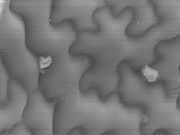Plant Cell
About Plant Cell
Plant cells are eukaryotic cells that differ in several key respects from the cells of other eukaryotic organisms. Their distinctive features include:» A large central vacuole, a sap-filled volume enclosed by a membrane known as the tonoplast maintains the cell's turgor, controls movement of molecules between the cytosol and sap, stores useful material and digests waste proteins and organelles.
» A cell wall composed of cellulose and hemicellulose, pectin and in many cases lignin, and secreted by the protoplast on the outside of the cell membrane. This contrasts with the cell walls of fungi (which are made of chitin), and of bacteria, which are made of peptidoglycan.
» Specialised cell-cell communication pathways known as plasmodesmata, pores in the primary cell wall through which the plasmalemma and endoplasmic reticulum of adjacent cells are continuous.
» Plastids, notably the chloroplasts which contain chlorophyll and the biochemical systems for light harvesting and photosynthesis, but also amyloplasts specialized for starch storage, elaioplasts specialized for
fat storage and chromoplasts specialized for synthesis and storage of pigments. As in mitochondria, which have a genome encoding 37 genes plastids have their own genomes of about 100-120 unique genes and probably arose as prokaryotic endosymbionts living in the cells of an early eukaryotic ancestor of the land plants and algae.
» Cell division by construction of a phragmoplast as a template for building a cell plate late in cytokinesis is characteristic of land plants and a few groups of algae, notably the Charophytes and the Order Trentepohliales.
» The sperm of Bryophytes have flagellae similar to those in animals, but higher plants, (including Gymnosperms and flowering plants) lack the flagellae and centrioles that are present in animal cells.
Tissue types
The major classes of cells differentiate from undifferentiated meristematic cells (analogous to the stem cells of animals) to form the tissue structures of roots, stems, leaves, flowers and reproductive structures.Xylem cells are elongated cells with lignified secondary thickening of the cell walls. Xylem cells are specialised for conduction of water, and first appeared in plants during their transition to land in the Silurian period more than 425 million years ago (see Cooksonia). The possession of xylem defines the vascular plants or Tracheophytes. Xylem tracheids are pointed, elongated xylem cells, the simplest of which have continuous primary cell walls and lignified secondary wall thickenings in the form of rings, hoops or reticulate networks.
More complex tracheids with valve-like perforations called bordered pits characterise the gymnosperms. The ferns and other pteridophytes and the gymnosperms only have xylem tracheids, while the angiosperms also have xylem vessels. Vessel members are hollow xylem cells aligned end-to-end, without end walls that are assembled into long continuous tubes. The bryophytes lack true xylem cells, but their sporophytes have a water conducting tissue known as the hydrome that is composed of elongated cells of simpler construction. Phloem is a specialised tissue for food conduction in higher plants. Phloem consists of two cell types, the sieve tubes and the intimately-associated companion cells. The sieve tube elements lack nuclei and ribosomes, and their metabolism and functions are regulated by the adjacent nucleate companion cells. Sieve tubes are joined end to end with perforate end-plates between known as sieve plates, which allow transport of photosynthate between the sieve elements. The companion cells, connected to the sieve tubes via plasmodesmata, are responsible for loading the phloem with sugars. The bryophytes lack phloem, but moss sporophytes have a simpler tissue with analogous function known as the leptome.
The epidermis of all aerial organs, but not roots, is covered with a cuticle made of waxes and the polyester cutin. Several cell types may be present in the epidermis. Notable among these are the stomatal guard cells, glandular and clothing hairs or trichomes, and the root hairs of primary roots. In the shoot epidermis of most plants, only the guard cells have chloroplasts. The epidermal cells of the primary shoot are thought to be the only plant cells with the biochemical capacity to synthesize cutin.
Parts
» Cell membrane» Cell wall
» Plasmodesma
» Vacuole
» Plastids
» Chloroplast
» Leucoplast
» Chromoplast
» Golgi Complex
» Ribosome
» Endoplasmic reticulum
» Mitochondrion
» Lysosome
» Cytoplasm
» Nucleus
» DNA
» Chromatin
» RNA
References
- JA Raven (1997) The vacuole: a cost-benefit analysis. Advances in Botanical Research 25, 59–86- RA Leigh and D Sanders (1997) Advances in Botanical Research, Vol 25: The Plant Vacuole. Academic Press, California and London.
- Oparka, KJ (1993) Signalling via plasmodesmata-the neglected pathway. Seminars in Cell Biogy 4, 131-138
- Hepler, PK (1982) Endoplasmic reticulum in the formation of the cell plate and plasmodesmata. Protoplasma 111, 121-133
- Anderson S, Bankier AT, et al. (1981) Sequence and organization of the human mitochondrial genome. Nature 290, 4–65
- L Cui, N Veeraraghavan, et al. (2006) ChloroplastDB: the chloroplast genome database. Nucleic Acids Research, 34, D692-696
- L. Margulis (1970)Origin of eukaryotic cells. Yale University Press, New Haven
- Lewis, LA, McCourt, RM (2004) Green algae and the origin of land plants. American Journal of Botany 91, 1535-1556
- López-Bautista, JM, Waters, DA and Chapman, RL (2003) Phragmoplastin, green algae and the evolution of cytokinesis. International Journal of Systematic and Evolutionary Microbiology 53, 1715-1718
- Manton, I. and Clarke, B. (1952) An electron microscope study of the spermatozoid of Sphagnum. Journal of Experimental Botany 3, 265-275
- D.J. Paolillo, Jr. (1967) On the structure of the axoneme in flagella of Polytrichum juniperinum. Transactions of the American Microscopical Society, 86, 428-433
- PH Raven , Evert RF, Eichhorm SE (1999) Biology of Plants, 6th edition. WH Freeman, New York
- MT Tyree; MH Zimmermann (2003) Xylem structure and the ascent of sap, 2nd edition, Springer-Verlag, New York USA
- EG Cutter (1977) Plant Anatomy Part 1. Cells and Tissues. Edward Arnold, London
- Kolattukudy, PE (1996) Biosynthetic pathways of cutin and waxes, and their sensitivity to environmental stresses. In: Plant Cuticles. Ed. by G. Kerstiens, BIOS Scientific publishers Ltd., Oxford, pp 83-108





